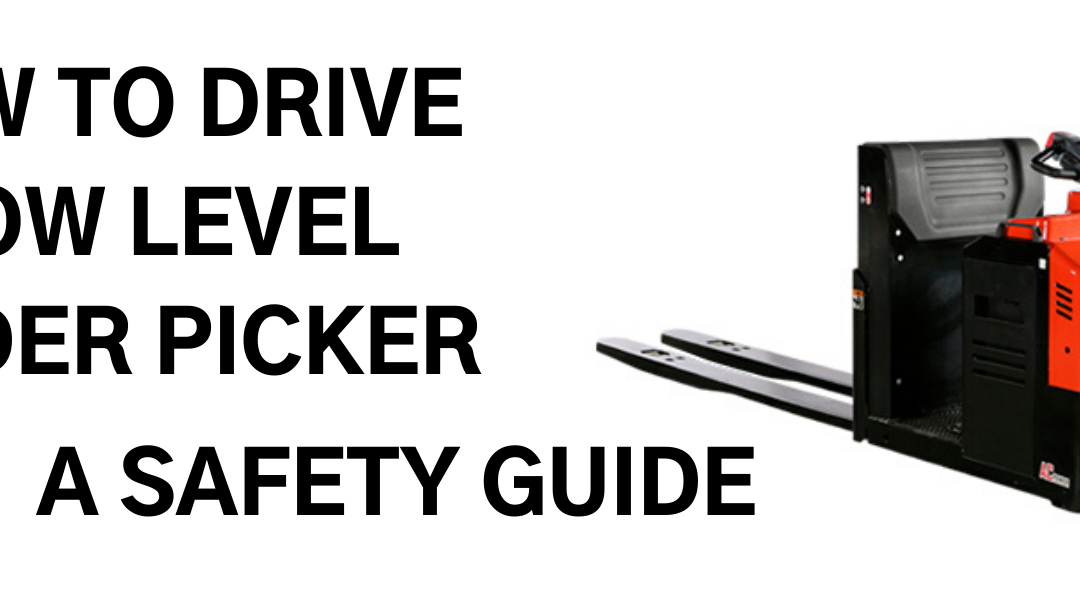Basic training, on how to drive a low-level order picker or any kind of ride-on pallet truck, is mandatory for anyone who wants to be an operator. This kind of material handling equipment is normally used in warehouses. They are efficient, easy, and cheap to operate, especially for high speed order picking and transporting heavy loads through long distances.
You must stick to all health and safety standards when operating a low-level order picker. Remember, you should perform inspection and maintenance regularly to get the most out of these pieces of equipment.
Operating a low level order picker
Don’t try to operate a low-level order picker until you receive adequate theory and practical training. Several tips will avoid equipment damage or physical injury. To keep your operations on track, follow these steps:
Before you start
- Know the maximum lifting capacity of the order picker. The metal data plate on the chassis normally displays this information. Notify your supervisor if the machine does not have a display of this information.
- Review all operator documentation, such as manuals. Crucial information in these documents may be unique to your equipment and not so obvious.
- Check for any disconnected, worn out or broken parts. Report any issues immediately to the supervisor.
- Familiarize yourself with the safety features, including the reversing switch or auto-braking system.
- Ensure a tight grip on the controls and the correct body balance.
Operating instructions
- First, unplug the battery from the charger and take out the charging cable.
- Set all forks at their lowest position.
- Twist the controller clockwise to move the machine forward and anticlockwise to move it in reverse.
- Use the controller to steer the low-level order picker into the direction you want to move.
- Use the control marked with an up arrow to raise the forks off the ground.
- To drive the machine to either side, use the tiller head. You only need to steer since the powerful motor will propel the machine in the desired direction.
- To pick up the pallet, lower the forks to the ground using the control marked with a down arrow. Once the pallet is in place, lift the forks and drive to the required destination.
- When you’ve done, plug the machine back to the charger.
Safety tips
Operating a low-level order picker safely is a mandatory safety policy to protect people, the company, and your equipment.
Be careful when driving the machine in areas with pedestrians or traffic. This is crucial in areas where other low-level order pickers are loading and unloading or coming out of the aisle. This constant assessment of risk should form the basis of work systems. You must also consider the extra risk associated with high speed driving operations.
Prohibit any unauthorized personnel from accessing areas where the machines are operating, and only allow operators or supervisors. In cases where this is not possible, consider the risk to pedestrians, and then provide risk control measures, including the following:
- Use a physical barrier to separate areas where machines are operating from pedestrian activities
- Define and mark the designated routes and crossing places for pedestrians
- Use several clear warnings to alert people that low-level order pickers are operating in the vicinity
- Display instructions for other operators to sound horns at suitable areas
- Use other visibility measures such as CCTV, mirrors, or reversing bleepers
All operating areas must be designed properly and maintained regularly. The surfaces should be firm and level, preferably concrete, especially for low level order pickers like the EPT20-RAP. Some other machines, like the ride on pallet truck RPL201, are designed to operate even in more uneven or rough surfaces.
Routine maintenance
Planned routine maintenance is essential as it helps the machine to run efficiently and identifies potential problems. Low-level order pickers are maintained based on their operating hours. The manufacturer’s handbook provides all the details about the model. If you operate in unusually harsh or corrosive conditions, there may be additional requirements.
Only people with relevant training, instruction and information like maintenance technicians should perform maintenance. As an operator, you should not perform adjustments or repairs, unless you have a permission to do so. Keep an updated record of all maintenance checks. Although it is not a legal requirement, keeping a maintenance log will help you identify any recurring issues.
As an operator, you should correctly perform routine maintenance tasks. Conduct a thorough examination of all the parts, such as the wheels, forks, drive unit, steering and brakes once a year. A competent person will perform the annual checks and draw up a scheme you can use for intermediate checks.
Before operating the machine, conduct pre-use checks so that you can report any defects immediately. Always carry a copy of the last inspection. The document identifies whether the work equipment is fit for operation, adjustment, and maintenance without causing any safety and health risks. You should report any defects and not use the machine until the faults are fixed.
Electrically powered lift trucks have powerful traction batteries, which require a correct maintenance. When charging regular lead acid batteries, make sure there are no sparks or flames nearby. Ignition sources can cause explosion.
Maintain the electrolyte at the recommended levels after charging the battery to ensure long battery lifetime. For this work, take well care of personal protective equipment.
Conclusion
Observe safety precautions when operating EP’s low-level order pickers. Ensure all pedestrians in the vicinity have designated areas to walk on to operate the machine efficiently. Check the equipment regularly and perform routine maintenance.
A high-quality and versatile pallet truck such as the EPT20-RAP will guarantee optimal performance. Even more if you observe all the tips discussed.
To talk more about our range of low-level order pickers, please contact us today.

